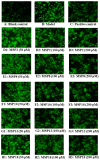Antioxidant Peptides from Monkfish Swim Bladders: Ameliorating NAFLD In Vitro by Suppressing Lipid Accumulation and Oxidative Stress via Regulating AMPK/Nrf2 Pathway
- PMID: 37367685
- PMCID: PMC10301360
- DOI: 10.3390/md21060360
Antioxidant Peptides from Monkfish Swim Bladders: Ameliorating NAFLD In Vitro by Suppressing Lipid Accumulation and Oxidative Stress via Regulating AMPK/Nrf2 Pathway
Abstract
In this study, we investigate the ameliorating functions of QDYD (MSP2), ARW (MSP8), DDGGK (MSP10), YPAGP (MSP13) and DPAGP (MSP18) from monkfish swim bladders on an FFA-induced NAFLD model of HepG2 cells. The lipid-lowering mechanisms revealed that these five oligopeptides can up-regulate the expression of phospho-AMP-activated protein kinase (p-AMPK) proteins to inhibit the expression of the sterol regulatory element binding protein-1c (SREBP-1c) proteins on increasing lipid synthesis and up-regulating the expression of the PPAP-α and CPT-1 proteins on promoting the β-oxidation of fatty acids. Moreover, QDYD (MSP2), ARW (MSP8), DDGGK (MSP10), YPAGP (MSP13) and DPAGP (MSP18) can significantly inhibit reactive oxygen species' (ROS) production, promote the activities of intracellular antioxidases (superoxide dismutase, SOD; glutathione peroxidase, GSH-PX; and catalase, CAT) and bring down the content of malondialdehyde (MDA) derived from lipid peroxidation. Further investigations revealed that the regulation of these five oligopeptides on oxidative stress was achieved through activating the nuclear factor erythroid 2-related factor 2 (Nrf2) pathway to raise the expression levels of the heme oxygenase 1 (HO-1) protein and downstream antioxidant proteases. Therefore, QDYD (MSP2), ARW (MSP8), DDGGK (MSP10), YPAGP (MSP13) and DPAGP (MSP18) could serve as candidate ingredients to develop functional products for treating NAFLD.
Keywords: AMPK/Nrf2 pathway; antioxidant peptide; monkfish (Lophius litulon); nonalcoholic fatty liver disease (NAFLD); swim bladders.
Conflict of interest statement
The authors declare no conflict of interest.
Figures











Similar articles
-
Eighteen Novel Bioactive Peptides from Monkfish (Lophius litulon) Swim Bladders: Production, Identification, Antioxidant Activity, and Stability.Mar Drugs. 2023 Mar 7;21(3):169. doi: 10.3390/md21030169. Mar Drugs. 2023. PMID: 36976218 Free PMC article.
-
Monkfish Peptides Mitigate High Fat Diet-Induced Hepatic Steatosis in Mice.Mar Drugs. 2022 May 5;20(5):312. doi: 10.3390/md20050312. Mar Drugs. 2022. PMID: 35621963 Free PMC article.
-
Antioxidant Peptides from Miiuy Croaker Swim Bladders: Ameliorating Effect and Mechanism in NAFLD Cell Model through Regulation of Hypolipidemic and Antioxidant Capacity.Mar Drugs. 2025 Feb 1;23(2):63. doi: 10.3390/md23020063. Mar Drugs. 2025. PMID: 39997187 Free PMC article.
-
Free radical biology for medicine: learning from nonalcoholic fatty liver disease.Free Radic Biol Med. 2013 Dec;65:952-968. doi: 10.1016/j.freeradbiomed.2013.08.174. Epub 2013 Aug 29. Free Radic Biol Med. 2013. PMID: 23994574 Review.
-
Activation of Nrf2/HO-1 signaling: An important molecular mechanism of herbal medicine in the treatment of atherosclerosis via the protection of vascular endothelial cells from oxidative stress.J Adv Res. 2021 Jul 6;34:43-63. doi: 10.1016/j.jare.2021.06.023. eCollection 2021 Dec. J Adv Res. 2021. PMID: 35024180 Free PMC article. Review.
Cited by
-
Antioxidant Peptides and Protein Hydrolysates from Tilapia: Cellular and In Vivo Evidences for Human Health Benefits.Foods. 2024 Sep 18;13(18):2945. doi: 10.3390/foods13182945. Foods. 2024. PMID: 39335873 Free PMC article. Review.
-
Erhong Jiangzhi Decoction Inhibits Lipid Accumulation and Alleviates Nonalcoholic Fatty Liver Disease with Nrf2 Restoration Under Obesity.J Inflamm Res. 2024 Dec 11;17:10929-10942. doi: 10.2147/JIR.S491484. eCollection 2024. J Inflamm Res. 2024. PMID: 39677297 Free PMC article.
-
Antioxidant Peptides from Hizikia fusiformis: A Study of the Preparation, Identification, Molecular Docking, and Cytoprotective Function of H2O2-Damaged A549 Cells by Regulating the Keap1/Nrf2 Pathway.Foods. 2025 Jan 26;14(3):400. doi: 10.3390/foods14030400. Foods. 2025. PMID: 39941997 Free PMC article.
-
Effect of Spirulina and Fish Processing By-Products Extracts on Citrinin-Induced Cytotoxicity in SH-SY5Y Cells.Foods. 2024 Jun 19;13(12):1932. doi: 10.3390/foods13121932. Foods. 2024. PMID: 38928871 Free PMC article.
-
Novel Ca-Chelating Peptides from Protein Hydrolysate of Antarctic Krill (Euphausia superba): Preparation, Characterization, and Calcium Absorption Efficiency in Caco-2 Cell Monolayer Model.Mar Drugs. 2023 Nov 5;21(11):579. doi: 10.3390/md21110579. Mar Drugs. 2023. PMID: 37999403 Free PMC article.
References
MeSH terms
Substances
Grants and funding
LinkOut - more resources
Full Text Sources
Medical
Miscellaneous

